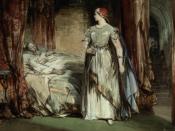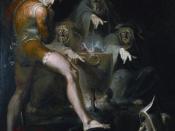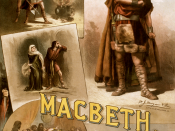Every good play has a certain elements that make it stand out from the other plays. An important one of these is the use of imagery. Good use of good imagery can make a play extraordinary and distinct. It refers to the use of symbols to create a sense of mood or atmosphere. An important part of imagery is the use of pathetic fallacies in the play. Pathetic Fallacy (also known as Allegory) is a tool of imagery that connects nature's behavior, in comparison to the unnatural events that occur. Shakespeare is well known for the use of this feature in several plays. Macbeth is a fine example illustrating Shakespeare's greatness as a playwright. He uses allegory to indicate the sequence of subsequent events in the play.
The play begins with the three weird sisters (Act I, scene 1), thus depicting the element of darkness that the play possesses. Every moment in the play, that involved the presence of the witches experienced thunder and lightening and took place in dark and isolated locations.
This symbolized the theme of darkness and isolation. They repeatedly say, "Fair is foul and foul is fair / hover through the fog and filthy air." This acts as a pathetic fallacy, alluding that they inhabit a world where the order is reversed. It is hard to tell which actions are good and which are evil.
Pathetic Fallacy comes into platy again when Macbeth kills King Duncan. Lady Macbeth hears the owl shriek and the crickets cry. These were considered as ill omens in those days. Also on the night when Duncan is murdered by Macbeth, his horses which were of the finest rank, turned wild and became disobedient as thou they were at war with humans; they ate each other.
The same night also experienced...



Macbeth
the essay is good and deals with the imagery well however the paragraph about the witches near the bottom of the essay repeats the same points made earlier. however it is well written and the language is of a high standard.
3 out of 3 people found this comment useful.